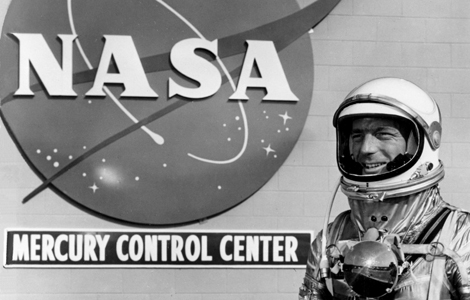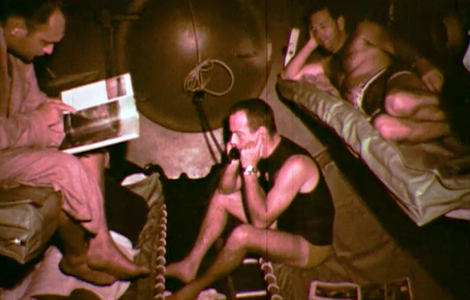Space Was Not the Weirdest Place Scott Carpenter Ever Went
The astronaut’s month-long stay on the ocean floor made his Mercury flight look like a Sunday drive
/https://tf-cmsv2-smithsonianmag-media.s3.amazonaws.com/filer/Carpenter-Aurora-631.jpg)
We’re right to eulogize early astronauts like Scott Carpenter (who passed away yesterday at the age of 88) for heroism in the face of unknown dangers. The Mercury astronauts and their Russian counterparts were, after all, the first people to venture off-Earth.
But Carpenter’s Mercury-Atlas 7 flight in 1962 lasted just five hours — three quick orbits, a Pacific splashdown, and that was the end of his space traveling. At the age of 40, the former Navy pilot then turned to exploring the ocean, which, he came to conclude, “is a much more hostile environment than space.” Carpenter’s experience on SEALAB II in the fall of 1965 bears this out.
SEALAB didn’t have a fraction of Mercury’s funding or publicity, but was just as daring in its own way. The Navy wanted to know if people could live underwater, in a highly pressurized habitat, for extended periods, where they could easily dive in deep water without the time-consuming preparation needed to avoid decompression sickness. SEALAB II was a 57-foot-long steel cylinder dropped to the ocean floor on the continental shelf off La Jolla, California. The pressure inside the habitat was 103 psi — seven times normal Earth atmosphere — to match the pressure at a depth of 203 feet. SEALAB’s hatch, a hole in the habitat’s floor protected by a shark cage, remained open to the water. The crew could put on their diving gear any time and just swim outside. A total of 28 men lived inside SEALAB, as many as ten at a time, during a 45-day span from August to October 1965. Of all the residents, Carpenter lived there longest — 30 days.
Years later, he told an interviewer that part of his motivation in signing up for SEALAB was to conquer an old fear. As a Navy pilot, he had once been on a raft in the middle of the ocean — part of a survival exercise — when a radar reflector needed to attract rescue teams suddenly fell in the water.
It went overboard, and I thought of trying to get it. But I was afraid of the sharks and the critters in that water, and I didn’t do it. But my gunner’s mate, without a second thought, jumped overboard, was gone for a long time, but he swam down and got that corner reflector and brought it back up. And I thought, “There is a brave man,” and it made me ashamed of myself. That was the genesis of my need to conquer my fear of the deep ocean. It’s an important thing. Conquering of fear is one of life’s greatest pleasures, and it can be done a lot of different places.
If living on SEALAB wasn’t exactly scary, it could be tremendously uncomfortable, bordering on painful, and was every bit as alien as life on a spacecraft. For one thing, everyone sounded like Mickey Mouse. The atmosphere in the lab was 85 percent helium (nitrogen at that pressure makes people act drunk, so it was replaced with helium). At first many of the crew thought this hilarious, but eventually the squeaky, party-balloon voices got annoying, because the men couldn’t understand each other. (They even tested a “helium descrambler” designed to make the helium voices more intelligible.) According to the SEALAB II project report, “when asked, ‘How soon were you able to understand all nine other aquanauts quite well?’ the responses showed that 16 divers felt they could in one to two days, eight more by the end of four days, two more by the eleventh day, and one never.” Carpenter got laughs when he pulled out a ukelele and sang “Goodnight Irene” in squeaky voice. But the problem became more serious — or funnier — when he tried to put in a call to President Lyndon Johnson from SEALAB. Here’s the full recording, starting with the topside officer who asks White House operators to stand by:
In a public talk in 1986, Carpenter discussed some of the other oddities of life on SEALAB. In that weird, alien atmosphere, you couldn’t whistle. Matches didn’t light. Working outside the habitat chilled you to the bone (the crew tested heated suits, but they leaked). Said one aquanaut later, “You accept the fact that part of the day is going to be spent being miserable .” Said another: “It’s hard work, it takes a long time to do simple tasks in the water. It takes a good hour to replace a (light) bulb.”
The project report goes on for paragraphs enumerating the hardships, from skin rashes to headaches, and is fairly blunt for an official document:
Working inside Sealab was no picnic either. Crowded conditions in the entrance area presented probably the most vexatious problems. The entrance area was a bottleneck in a very literal sense. Men crowded around in bulky and uncomfortable gear waiting to get into the water. There was almost no place to stow gear out of the way. The habitat sat unevenly on the bottom, with a list of six degrees in two directions. As a result, drawers would slide open or shut, objects would fall off counters, and men would walk up or down hill while leaning sideways. Long hours of careful preparation were required to put a man in the water, and the work schedule was constantly interrupted, delayed, and revised by emergencies or necessities. Work time far exceeded an eight-hour day. Communications with topside and within the capsule were difficult at best, due to the problems of understanding helium speech, and aggravated by constant background noise which rose to a level rendering verbal communication nearly impossible when the Arawak pumps were running. Work involving writing was made difficult by lack of privacy and the fact that writing surfaces were not level and extremely limited in space.
And yet, like the early astronauts, the SEALAB crews suffered the indignities willingly, because they believed they were doing something historic in exploring the deep ocean frontier. The project scientists wrote: “The sentiment behind this high motivation was probably best expressed by one of the divers on Team 1 who, upon being congratulated, responded, “Hell, I’m no hero, 10,000 other Navy divers would have given their right arm to have been in Sealab.”

